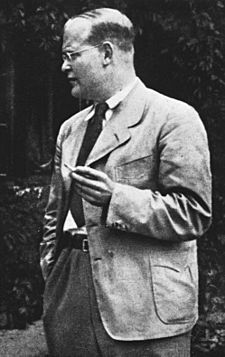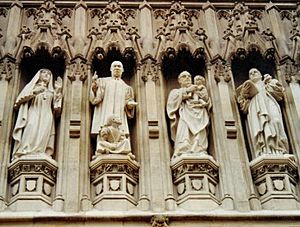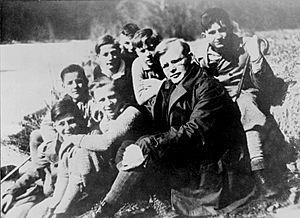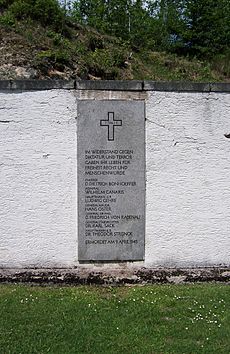Dietrich Bonhoeffer facts for kids
Quick facts for kids Dietrich Bonhoeffer |
|
 |
|
| Born | 4 February 1906 in Breslau, Silesia, Prussia, Germany (now Wrocław, Poland) |
|---|---|
| Died | 9 April 1945 (aged 39) in Flossenbürg, Bavaria, Germany |
| Church | Evangelical Church of the old-Prussian Union (1906–1933) Confessing Church (1933–1945) |
| Education | Staatsexamen (Tübingen), Doctor of Theology (Berlin), Privatdozent (Berlin) |
| Writings | Author of several books and articles (see below) |
| Congregations served | Zion's Church congregation, Berlin German-speaking congregations of St. Paul's and Sydenham, London |
| Offices held | Associate lecturer at Frederick William University of Berlin (1931–1936) Student pastor at Technical College, Berlin (1931–1933) Lecturer of Confessing Church candidates of pastorate in Finkenwalde (1935–1937) |
Dietrich Bonhoeffer (4 February 1906 – 9 April 1945) was a German Lutheran pastor and theologian. He was a brave person who spoke out against the Nazis. He also helped start the Confessing Church, a group of Christians who resisted Hitler.
His ideas about how Christians should live in the world are still very important today. His 1937 book, The Cost of Discipleship, is a famous book about following Jesus. Bonhoeffer was known for strongly opposing the Nazi government. He spoke out against their terrible actions, like harming people with disabilities and persecuting Jewish people.
The Gestapo (the Nazi secret police) arrested him in April 1943. He was held in Tegel prison for a year and a half. Later, he was moved to Flossenbürg concentration camp.
Bonhoeffer was accused of being involved in the 20 July plot. This was a secret plan to assassinate Adolf Hitler. He was executed on 9 April 1945, just as the Nazi government was falling apart.
Early Life and Education
Growing Up in Germany
Dietrich Bonhoeffer was born on 4 February 1906 in Breslau, Germany. This city is now in Poland. He grew up in a large family with seven brothers and sisters. Dietrich had a twin sister named Sabine.
His father, Karl Bonhoeffer, was a famous doctor who studied the brain. His mother, Paula Bonhoeffer, was a teacher. His family encouraged him to learn and be curious. This helped him become a leader, especially in the church.
Many of his family members were also very smart and brave. His oldest brother, Karl Friedrich Bonhoeffer, became a chemist. His brother Walter died fighting in World War I when Dietrich was 12. Another brother, Klaus, was a lawyer who was later executed for being part of the plot against Hitler.
Dietrich's older sisters, Ursula and Christel, married men who were also executed by the Nazis. Christel was imprisoned but survived.
Studying Theology
Bonhoeffer studied theology at the University of Tübingen. He earned a high-level degree there. At just 21 years old, he completed his Doctor of Theology degree from Humboldt University of Berlin. He graduated with the highest honors.
Time in America
In 1930, when he was 24, Bonhoeffer went to the United States. He studied at Union Theological Seminary in New York City. He felt that the theological education there wasn't very deep.
However, this trip changed his life. He made important friends and learned a lot. He met Frank Fisher, a Black student, who took him to the Abyssinian Baptist Church in Harlem. Bonhoeffer taught Sunday school there. He grew to love African-American spiritual songs.
He also heard Adam Clayton Powell Sr. preach about social justice. Bonhoeffer became very aware of the unfair treatment of minority groups in the US. He saw how churches struggled to bring people together. He started to see things "from below," meaning from the viewpoint of people who were suffering. He said that in Harlem, he could truly hear about "sin and grace and the love of God." This experience helped him focus on real-world problems instead of just theories.
Bonhoeffer's Career
After returning to Germany in 1931, Bonhoeffer became a teacher at the University of Berlin. He taught about Christian beliefs. He was very interested in bringing different churches together. He became a youth secretary for a group that worked for international friendship among churches.
Around this time, Bonhoeffer became a deeply committed man of faith. He decided to truly live out the teachings of Jesus. On 15 November 1931, at age 25, he became a pastor in Berlin.
The Confessing Church
The Nazis came to power on 30 January 1933. This greatly changed Bonhoeffer's promising career. He immediately became a strong opponent of the Nazi government. Just two days after Hitler became Chancellor, Bonhoeffer spoke on the radio. He criticized Hitler and warned Germany not to worship a leader who could turn out to be a "misleader." His broadcast was suddenly cut off.
In April 1933, Bonhoeffer was one of the first church leaders to speak out against Hitler's persecution of Jewish people. The Nazis tried to control the German Protestant churches. They wanted to remove pastors of Jewish descent. Bonhoeffer saw this as wrong because it went against the idea of baptism.
In response, Martin Niemöller started the Pastors' Emergency League. This group grew into the Bekennende Kirche (Confessing Church). This church aimed to keep traditional Christian beliefs and practices. The Barmen Declaration, written in May 1934, stated that Jesus Christ, not Hitler, was the head of the church.
Ministry in London
In late 1933, Bonhoeffer refused a church job in Berlin because of the Nazi policies. Instead, he became a pastor for two German-speaking churches in London, England. He told his friend Karl Barth that he needed to step away from the conflict in Germany for a while.
Barth strongly disagreed. He told Bonhoeffer that he was running away from the fight. He urged Bonhoeffer to return to Berlin because "the house of your church is on fire."
Bonhoeffer did not go to England just to avoid trouble. He hoped to use the international church movement to help the Confessing Church. He stayed in close contact with Martin Niemöller by phone. He spoke at international meetings, urging people to oppose the Nazi-supported church movement.
Secret Seminaries
In 1935, Bonhoeffer decided to return to Germany. He became the head of a secret seminary in Finkenwalde. This seminary trained pastors for the Confessing Church. The Nazis were trying to shut down the Confessing Church.
In August 1936, Bonhoeffer was banned from teaching at the University of Berlin. He was called a "pacifist and enemy of the state." The Gestapo closed the Finkenwalde seminary in September 1937. Many pastors and students were arrested.
Around this time, Bonhoeffer published his famous book, The Cost of Discipleship. In it, he wrote about "costly grace," meaning that following Jesus truly costs something. He criticized "cheap grace," which he saw as an excuse for not living a good life.
For the next two years, Bonhoeffer secretly traveled to different villages in eastern Germany. He continued to teach his students in "seminaries on the run." The von Blumenthal family and the von Kleist family helped him by hosting these secret schools on their estates.
In March 1940, the Gestapo finally shut down the last secret seminary. Bonhoeffer's experiences at Finkenwalde helped him write The Cost of Discipleship and Life Together. His sister, Sabine, and her Jewish husband escaped to England in 1938.
Joining the Resistance
In 1938, Bonhoeffer began to connect with members of the German Resistance. His brother-in-law, Hans von Dohnányi, introduced him to a group planning to overthrow Hitler. This group was part of the Abwehr, the German military intelligence service.
Bonhoeffer learned that war was coming. He was worried about being forced to join the army. As a committed pacifist, he could not swear an oath to Hitler or fight in his army. Refusing military service could lead to death.
In June 1939, Bonhoeffer went to the United States again. However, he quickly regretted his decision. He felt he needed to be in Germany during this difficult time. He returned after only two weeks.
Working for the Abwehr
Back in Germany, the Nazi authorities continued to bother Bonhoeffer. He was forbidden to speak in public or publish his writings. In 1941, he joined the Abwehr. Dohnányi helped him join, saying that Bonhoeffer's international contacts would be useful. This also protected him from being drafted into the army.
Bonhoeffer learned about the terrible Nazi crimes through the Abwehr. He believed that a responsible person must think about how future generations will live. He knew that joining the plot against Hitler meant taking on guilt. He wrote that before God, he could only hope for grace.
Bonhoeffer acted as a messenger for the German resistance. He tried to tell the Western Allies about the resistance's plans. He hoped to get their support and find a way to make peace after Hitler was gone. His trips to other countries were disguised as intelligence work for the Abwehr.
In May 1942, he met with Bishop George Bell of Chichester in England. Through him, Bonhoeffer tried to reach the British government. However, the British government did not respond to these efforts. Dohnányi and Bonhoeffer also helped Jewish people escape to Switzerland. During this time, Bonhoeffer worked on his book Ethics, but it was unfinished when he was arrested.
Imprisonment and Execution
On 13 January 1943, Bonhoeffer became engaged to Maria von Wedemeyer. She was the granddaughter of his friend and supporter, Ruth von Kleist Retzow. Maria was 18 and Bonhoeffer was 36. They did not see each other much between their engagement and his arrest.
Bonhoeffer was arrested on 5 April 1943. He was held at Tegel Prison for a year and a half. While there, he continued to help other prisoners and even guards with their faith. Sympathetic guards helped him send letters out of prison. These letters were later published in Letters and Papers from Prison. One guard even offered to help him escape, but Bonhoeffer refused. He feared that his family, especially his brother Klaus and brother-in-law Hans, would be harmed by the Nazis.
After the 20 July Plot to kill Hitler failed in 1944, secret documents were found. These documents showed Bonhoeffer's connection to the plot. He was moved to a high-security Gestapo prison. In February 1945, he was secretly moved to Buchenwald concentration camp, and then to Flossenbürg concentration camp.
On 4 April 1945, Hitler found Admiral Wilhelm Canaris's diaries. Canaris was the head of the Abwehr. Hitler was furious and ordered that the plotters be killed. Bonhoeffer was taken away just after finishing his last Sunday service. He asked an English prisoner to tell Bishop George Bell that "This is the end—for me the beginning of life."
Bonhoeffer was sentenced to death on 8 April 1945. He was executed at dawn on 9 April 1945 in Flossenbürg concentration camp. Six other people were executed with him, including Admiral Canaris. Bonhoeffer's brother, Klaus Bonhoeffer, and his brother-in-law, Rüdiger Schleicher, were executed later in Berlin. His brother-in-law Hans von Dohnányi was executed on the same day as Bonhoeffer.
No one knows what happened to Bonhoeffer's body. It may have been cremated or buried in a mass grave with other prisoners.
Bonhoeffer's Legacy

Dietrich Bonhoeffer's life and ideas have greatly influenced Christians around the world. He was a smart and spiritual pastor who lived what he preached. He was killed because he stood up to the Nazis.
His life inspired leaders like Martin Luther King Jr. and the Civil Rights Movement in the United States. He also inspired people in Eastern Europe who fought against communism during the Cold War.
Many Christian churches remember Bonhoeffer on 9 April, the day he died. Some churches, like parts of the Anglican Communion, see him as a martyr (someone who dies for their faith). The United Methodist Church officially recognized him as a "modern-day martyr" in 2008.
The German Lutheran Church in Sydenham, London, where he preached, was destroyed in 1944. A new church was built in 1958 and named Dietrich-Bonhoeffer-Kirche in his honor.
Bonhoeffer's prayer, "By Gentel Powers," is a well-known worship song. It is often sung at funerals. In 2021, it was voted the most popular hymn in Germany.
His Ideas and Influence
Even though his life ended too soon, Bonhoeffer's theological ideas have been very important. His writings are not always complete, which means people sometimes interpret them differently.
A main idea in Bonhoeffer's theology is Jesus Christ. He believed that God became human in Jesus. Bonhoeffer thought that Christians should not hide from the world. Instead, they should act within it. He believed that faith means working for justice and sharing in God's suffering. He said that the church must share in "the sufferings of God" to be a true church of Christ.
In his prison letters, Bonhoeffer asked important questions about Christianity's role in a "world come of age." He wondered about a "religionless Christianity," where God is understood without old religious ideas. He saw the failure of the German church against Nazism as a chance for Christianity to become new again.
Some thinkers later took Bonhoeffer's ideas further. They developed the "Death of God" movement in the 1960s. However, many scholars believe these interpretations misunderstood Bonhoeffer's true meaning. More recent studies are careful to respect his original ideas.
Bonhoeffer's Writings
Many of Bonhoeffer's books and lectures have been translated into English. These works help us understand his ideas and his life.
Some of his most famous books include:
- Sanctorum Communio (1930): This was his first major work, exploring the idea of community in the church.
- Act and Being (1931): This book looked at how people understand themselves and God.
- Creation and Fall (1932): This work focused on the importance of God's word.
- The Cost of Discipleship (1937): This is his most widely read book. It talks about what it truly means to follow Jesus. He wrote, "Cheap grace is the mortal enemy of our church. Our struggle today is for costly grace."
- Life Together (1939): This book shares his thoughts on Christian community, based on his experiences at the Finkenwalde seminary.
- Ethics (unfinished, published 1955): This book shows his ideas for a Christian way of living in the world after the war.
- Letters and Papers from Prison (published after his death): This collection includes his letters from prison to his family and friends. It shows his thoughts on faith, resistance, and his personal life during his imprisonment.
His papers are kept at the Burke Library at Union Theological Seminary in New York.
See also
 In Spanish: Dietrich Bonhoeffer para niños
In Spanish: Dietrich Bonhoeffer para niños





